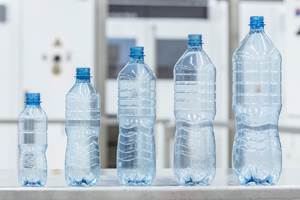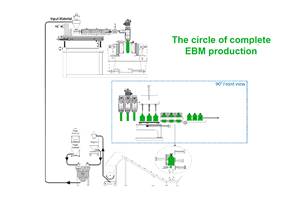New Polypropylene Families for Packaging, Blends & Composites
Two new lines of polypropylene resins from Basell North America challenge PS, PET, PVC, and other PPs for clear, rigid packaging.
Two new lines of polypropylene resins from Basell North America challenge PS, PET, PVC, and other PPs for clear, rigid packaging. They offer new balances of properties in thermoformed, stretch-blow molded, and injection molded parts.
Basell has a third new family of PPs—functionalized resins that can play roles as varied as dispersants for flame retardants, compatibilizers for engineering thermoplastic blends, and coupling agents for reinforced polyolefin composites.
Clear, tough & stiff
A wide variety of consumer packaging is the target for Basell’s new Adstif PP family. They are produced with Basell’s Sphe ripol process for use in cast film, sheet, and thermoforming. (Earlier Adstif grades were made with the Catalloy process and were used as blending resins for injection molding auto parts.)
Due to their very broad molecular-weight distribution, these re sins boast an enhanced balance of impact, stiffness, and HDT beyond that of standard PP. Moreover they offer a balance of clarity and stiffness that is comparable to or better than PS, PET, and PVC.
Four grades are currently available: Adstif X83-1 is a 3.5 MFR homo polymer for deli containers, drink cups, and lids. X34-1 and X65-1 are described as typical reactor-grade impact copolymers with 15% rubber content and 3.5 MFR. X34-1 is designed for frozen dairy and ice-cream containers. X-65-1 is suitable for stadium cups and corrugated sheet.
Adstif X786-1 is a 4 MFR impact copolymer with less than half the rubber content of conventional impact copolymers. It is designed for refrigerator storage containers like margarine tubs, yogurt cups, and portion packaging.
| Table 1-ADSTIF VS. PS in Deep-Draw Drink Cups | ||
| Adstif X83-1 (Homopol.) | 60/40 HIPS/GPPS | |
| Weight, g Haze, % Clarity, % Tensil Mod., kpsi Top Loads, lb Container Impact, g @5C | 4.0 4 97 305 21.4 96 | 3.9 4 86 294 4.5-5.6 68 |
Basell says Adstif thermoformed containers have better clarity and impact strength at lighter weight than PS containers. For example, a 230-cc, deep-draw drink cup produced with Adstif X83-1 demonstrated better container impact, top-load strength, and clarity than a PS cup (see Table 1). Note that the PP cup was downgauged to 2.1 g from 3.9 g for PS, a 46% weight reduction, while still showing superior performance.
Similar results have been achieved with medium-draw cheese containers, where Adstif provided weight savings of 32% versus a HIPS/GPPS blend and 17% lower weight than a standard PP homopolymer.
In multilayer cast film applications such as bread bags, Adstif reportedly provides higher strength, stiffness, and barrier properties than standard PP. Moreover, productivity gains can be substantial. On high-speed horizontal packing lines, Adstif resin allowed for production of up to 350 bags/ min without losing strength, compared with conventional PP, which starts to lose strength at rates above 310 bags/min.
mPP challenges PET, PE, PS
Basell has expanded its family of Metocene metallocene-catalyzed polypropylene (mPP) with the launch of new injection and stretch-blow molding grades that boast improved clarity and low migration of extractables.
| Table 2-Metocene mPP vs. Standard PP Containers (Injection Stretch-Blow Molded) | ||
| Standard PP | Metocene mPP | |
| Sidewall Haze, % Gloss, Top Load @ yield, lb Container Drop Impact,F50, ft | 7 66 50 10 | 1.5 82 60 10 |
Metocene X50182 is an 18 MFR grade for oriented bottles and jars that was launched to compete with PET and HDPE in hot-fill applications. These include bottles and jars for flavored water, sports drinks, chilled juices, and apple sauce. Testing of this resin on a two-stage Sidel reheat stretch-blow machine yielded bottles approaching the clarity of PET (1.5% haze) along with higher gloss than conventional PP (Table 2).
Metocene X70293 (40 MFR) and X50109 (60 MFR) are two new injection molding resins aimed at medical labware and optical-disk cases. In addition to high clarity, low migration of extractables, and excellent dimensional stability, these grades meet FDA and USP Class VI specs and are autoclavable.
Metocene has been shown to outclass crystal PS in CD-ROM cases with a 40% weight savings, 10% faster cycle time, improved shatter resistance, and lower tooling costs. The Metocene boxes featured integral hinges and a side-release mechanism that prevents data corruption. Translucent Meto cene is also easily colorable.
Other uses include housewares and other consumer products as well as thin-wall cups and containers. In many PS replacement applications, including containers and coathangers, Metocene can provide 15% weight savings due to lower resin density. Metocene coathangers reportedly have a similar appearance to hangers made of GPPS/HIPS blends, while providing weight savings of up to 35%, along with greater shatter resistance and improved processing.
New functionalized PP
Basell’s new and versatile oxypolypropylene is a polar-functional PP resin family with oxygenated groups. It is designed for use as a flame retardant dispersant and coupling agent/compatibilizer in engineering thermoplastic blends and reinforced polyolefins.
To produce oxyPP, Basell uses the same patented radiation technology that it uses to make its high-melt-strength resins. The company is aiming to produce oxyPP in a range of MFRs and functionality levels.
One initial focus is flame-retardant compounds. By playing the role of a dispersant, oxyPP reportedly allows reduced levels of halogenated and non-halogenated FRs without loss of flame resistance. When blended with a brominated FR compound for injection molded appliance parts like tv housings, oxyPP maintained equivalent UL 94 ratings with less than half the original amount of the halogenated flame retardant, Basell claims.
OxyPP has also been shown to give an order of magnitude higher MFR, up to 30% higher strength, and better surface appearance than a non-halogenated FR-PP compound.
Basell says oxyPP resins and its ionomer forms can yield compatible alloys with engineering thermoplastics. For example, a 25/75 blend of oxyPP and nylon 6 reportedly outperforms a similar blend of maleated PP and nylon: Tensile and flexural strength increases 10% to 25%, the MFR is quadrupled, and the color is more consistent.
OxyPP’s utility as a coupling agent is evident from tests of 30% glass-filled polyethylene: Addition of 10% of oxyPP reportedly provided effective wet-out of the glass fibers and substantially improved flex modulus, tensile strength, flexural strength, impact strength, and HDT. Good results were also obtained with oxyPP in glass-filled PP.
Related Content
First Water Bottles With Ultrathin Glass Coating
Long used for sensitive juices and carbonated soft drinks, KHS Freshsafe PET Plasmax vapor-deposited glass coating is now providing freshness and flavor protection for PET mineral water bottles.
Read MoreFor Extrusion and Injection-Blow Molders, Numerous Upgrades in Machines and Services
Uniloy is revising its machinery lines across the board and strengthening after-sales services in tooling maintenance, spare parts and tech service.
Read MoreGet Color Changes Right In Extrusion Blow Molding
Follow these best practices to minimize loss of time, material and labor during color changes in molding containers from bottles to jerrycans. The authors explore what this means for each step of the process, from raw-material infeed to handling and reprocessing tails and trim.
Read MorePolyJohn Turns to Blow Molding, Doubles Its Productivity
Leading maker of portable sanitation products knew thermoforming, sheet extrusion, rotomolding and injection molding. Then it found the missing link to higher productivity and new markets: blow molding.
Read MoreRead Next
Making the Circular Economy a Reality
Driven by brand owner demands and new worldwide legislation, the entire supply chain is working toward the shift to circularity, with some evidence the circular economy has already begun.
Read MoreSee Recyclers Close the Loop on Trade Show Production Scrap at NPE2024
A collaboration between show organizer PLASTICS, recycler CPR and size reduction experts WEIMA and Conair recovered and recycled all production scrap at NPE2024.
Read MoreFor PLASTICS' CEO Seaholm, NPE to Shine Light on Sustainability Successes
With advocacy, communication and sustainability as three main pillars, Seaholm leads a trade association to NPE that ‘is more active today than we have ever been.’
Read More

















